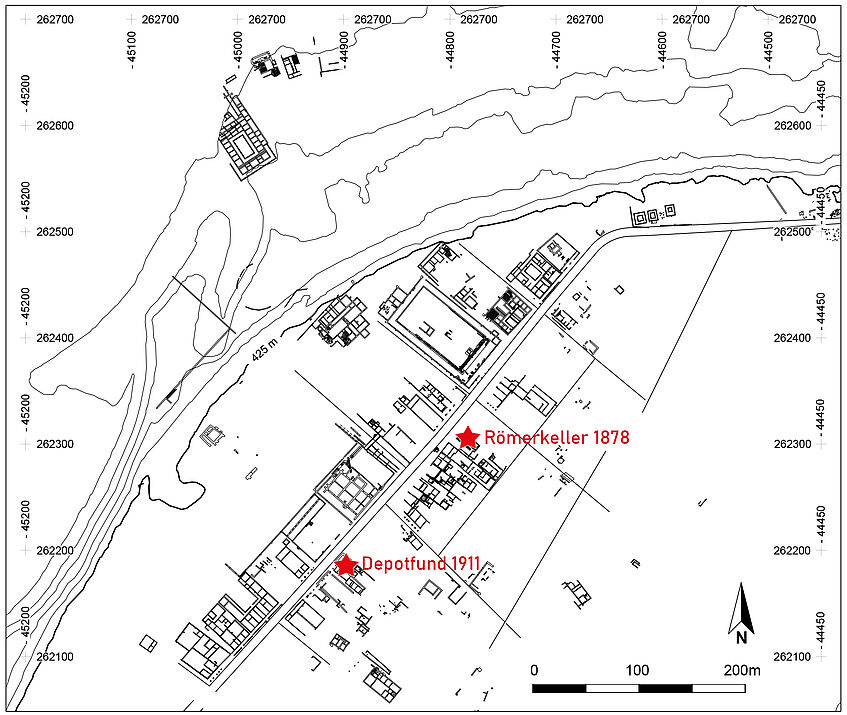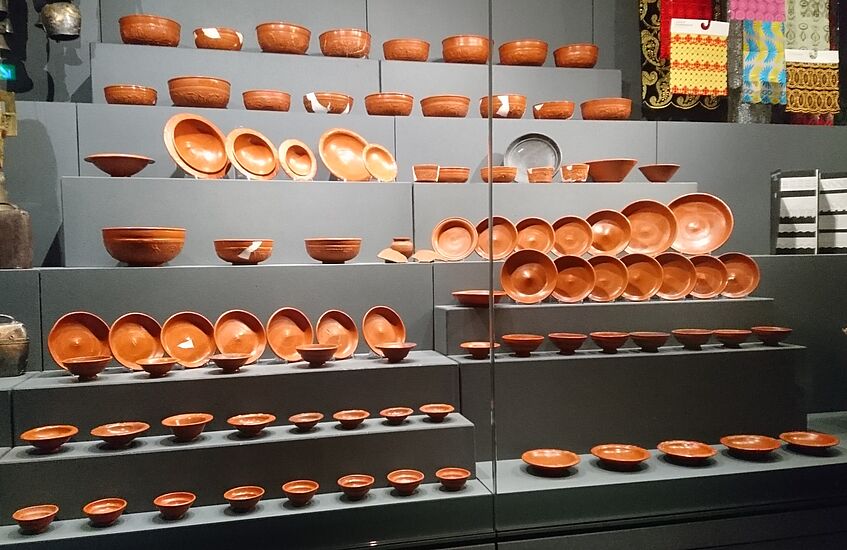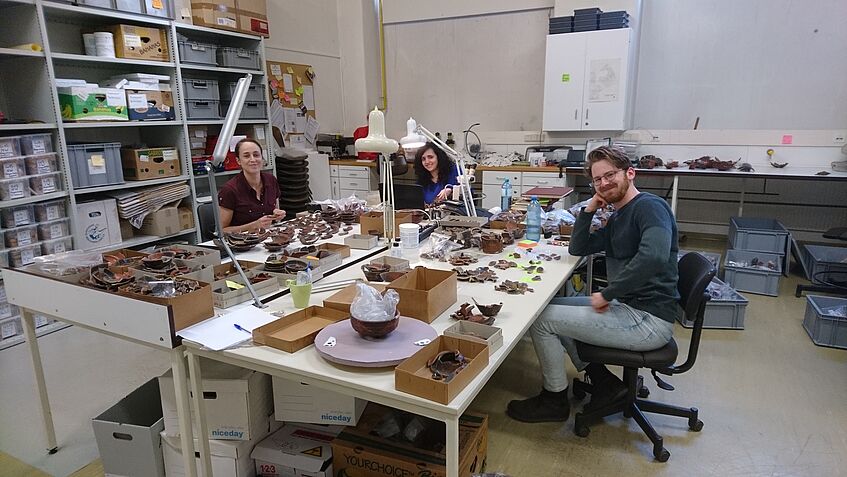Meaningful sherds: sigillata from pre-consumption deposits
Project organiser: Institute of Classical Archaeology
Project leader: Mag. Mag. Dr. Julia Kopf
Project staff: Marina Palmieri, MA, Olivér Borcsányi, BA; Elisabeth Todt, BSc BA
Financing: Austrian Science Fund (FWF, project P 34600-G)
Duration of the project: 01.10.2021 – 30.09.2024
Co-operation partners: vorarlberg museum / Bregenz, Dr. Małgorzata Daszkiewicz / ARCHEA (chemical analyses)

Plan of the Middle Imperial building structures of Brigantium with the locations of the Terra Sigillata find complexes relevant to the project (data: K. Oberhofer / A. Picker / U. Reiterer, Von der groma zum GIS. Der digitale Stadtplan von Brigantium/Bregenz. Fundber. Österreich 55, 2016 (2018), 535–554)

Terra Sigillata from the Römerkeller 1878 in the exhibition “buchstäblich Vorarlberg” at the vorarlberg museum in Bregenz (photo: J. Kopf)
Due to its potential for the dating of sites and find assemblages and its wide distribution in the Roman Empire, Terra Sigillata, a red, glossy tableware, belongs to the most exhaustively investigated groups of findings in Roman Archaeology. However, many important assemblages have not been documented, analysed and published in a scientific up-to-date way so far. This deficit also applies to the material of numerous pottery shops and store-rooms in the provinces of the Roman Empire, assignable to the category of pre-consumption deposits. This term describes ceramic assemblages which got buried before they could have been used and comprises finds of all steps of the trade chain, from wasters disposed of at the kiln sites over sunken cargos up to pottery shops at the destinations. The latter deposits usually did not come up for sale because they had been destroyed by a fire incident.
The project aims to process and publish two Terra Sigillata deposits from Brigantium/Bregenz (Austria), excavated more than one hundred years ago (Römerkeller 1878 and Depotfund 1911), and to contribute to the methodological and theoretical research on pre-consumption deposits, a field only explored rudimentarily so far. From pre-consumption deposits information on morphological aspects of the vessels (e. g. development of form and size, standardisation of the production) as well as to the functional composition of ceramic consignments (e. g. ratio of form groups and relevance of the represented potters for the specific type distribution) can be deduced. The focus lies on deposits at the destinations. Because of the fact that material from pottery shops and store-rooms represents a part of originally much larger assemblages (kiln loads), promising results can be expected from their analysis. These include for instance knowledge on the selection processes leading from kiln loads of about 30.000 vessels to a few hundred objects in a pottery shop, and on networks of potters (Which potters worked at the same time and delivered their products to the same destinations?).
Methodologically, apart from the traditional archaeological documentation of the assemblages from Bregenz in form of a catalogue and associated illustrations, statistical procedures are employed for the scientific examination. Moreover, microscopical and chemical analyses of selected ceramic sherds are conducted to determine their provenance and enquiries in the Samian research database of the Römisch-Germanische Zentralmuseum Mainz play an important role. In order to make the numerous potters’ stamps of the two deposits from Bregenz available for the scientific community as far as possible, they will be added to this open access database which has simplified the designation of stamps and decoration on Terra Sigillata considerably and offers exciting new options for scientific analyses.
Publications
- J. Kopf / M. Palmieri, Un "pre-consumption deposit" de céramique sigillée à Brégence/Brigantium (Autriche). In: SFECAG, Actes du Congrès de Clermont-Ferrand, 26–29 mai 2022 (Marseille 2022) 355–360.
Project-related thesis
- M. Palmieri, Pre-consumption deposits: An examination regarding the production of Terra Sigillata and its trading network in the 2nd c. AD (Dissertation in Arbeit)
- E. Todt, Die Terra Sigillata des Kellerfundes 1878 aus Brigantium/Bregenz (Masterarbeit Univ. Wien 2024)
Project-relevant literature
- W. Czysz, Der Sigillata-Geschirrfund von Cambodunum-Kempten. Ein Beitrag zur Technologie und Handelskunde mittelkaiserzeitlicher Keramik. Ber. RGK 63, 1982, 281–348.
- K. Dzwiza, Ein Depotfund reliefverzierter südgallischer Terra Sigillata-Schüsseln aus Pompeji. Jahrb. RGZM 51, 2004, 381–587.
- M. Fulford, Shops, Stalls, Stores: Pre-consumption Deposits and Centrally Organised Distribution in Antonine Britain. Britannia 45, 2014, 279–284.
- M. Fulford / E. Durham (Hrsg.), Seeing Red. New Economic and social perspectives on Terra Sigillata. Bull. Inst. Class. Stud. Suppl. 102 (London 2013).
- B. Hartley / B. M. Dickinson (Hrsg.), Names on Terra Sigillata. An index of makers' stamps & signatures on Gallo-Roman Terra Sigillata (Samian Ware). Bull. Inst. Class. Stud. 102 (London 2008–2012).
- A. Hild, Archäologische Forschungen in Bregenz. Jahresh. Österr. Arch. Inst. 26, 1930, 115–176 (Beibl.) bes. 122–125.
- J. Jacobs, Sigillatafunde aus einem römischen Keller zu Bregenz. Jahrb. Altkde. 6, 1912, 172–184.
- S. Jenny, Bauliche Ueberreste von Brigantium. Rechenschaftsber. Ausschuss Vorarlberger Mus.-Ver. 20, 1880, 10–26 bes. 16–18.
- J. Kopf, Ein früher südgallischer Terra-Sigillata-Sammelfund aus Bregenz: Überrest eines militärischen Keramikdepots? Jahrb. RGZM 62, 2015, 135–254.
- M. Rhodes, Roman Pottery lost en route from the kiln site to the user – A Gazetteer. Journal Roman Pottery Stud. 2, 1989, 44–58.

The project staff Elisabeth Todt, Marina Palmieri and Olivér Borcsányi in the ceramic room of the institute (photo: J. Kopf)
